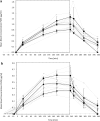Impact of physical activity on ethoxy- and propoxypropanol human toxicokinetics in vivo
- PMID: 40471273
- PMCID: PMC12408761
- DOI: 10.1007/s00204-025-04094-0
Impact of physical activity on ethoxy- and propoxypropanol human toxicokinetics in vivo
Abstract
Organic solvents such as propylene glycol ethers (PGEs) represents more than 20 different substances and are incorporated in thousands of commercial and professional products. Two PGEs commonly used in Europe and found mainly in cleaning and water-based paint products are propylene glycol ethyl ether (PGEE) and propylene glycol propyl ether (PGPE). Given their volatile properties, inhalation is the most common route of exposure. The aim of this study was to characterize human toxicokinetics following PGEE and PGPE inhalation exposure. The participants were exposed (4 h) at rest to a single PGE (between 15 and 35 ppm) under controlled conditions and blood, urine, and exhaled breath were collected. Our study shows that both PGEs were rapidly detected in blood (absorption rate: 0.01 µg/mL/h*ppm) and elimination was more important through urine (half-life: 1 h) than exhaled breath (half-life: 2 min). We also evaluated the impact of a moderate physical activity (30 min, 100 W) during exposure. A significant increase of blood absorption (absorption rate: 0.03 µg/mL/h*ppm) and internal dose (increase of 48%) was observed. Our results confirm that both PGEs are easily absorbed at rest and even faster with a moderate physical activity. The biomonitoring approach we have developed here allow the measurement of the "real" internal dose in workers handling these solvents. The existing occupational exposure limits do not consider workload, which may lead to their underestimation. Therefore, we recommend the use of biomonitoring for future studies and the consideration of physical workload for future exposure limits settings as an important parameter for risk assessment.
Keywords: Absorption; Activity; Chemical exposure; Elimination; Propylene glycol ethyl ether; Propylene glycol propyl ether.
© 2025. The Author(s).
Conflict of interest statement
Declarations. Conflict of interest: The authors declare that they have no conflict of interest. Ethical approval: This non-clinical human study was approved by the Swiss Commission on Ethics in Human Research (Swissethics) (no. project 2022–01567). All participants signed a written informed consent approved by the CERVD before admitted into the study.
Figures




References
-
- Borgatta M, Hechon J, Wild P, Hopf NB (2021) Influence of collection and storage materials on glycol ether concentrations in urine and blood. Sci Total Environ 792:148196. 10.1016/j.scitotenv.2021.148196 - PubMed
-
- Borgatta M, Wild P, Hopf NB (2022) Blood absorption toxicokinetics of glycol ethers after inhalation: a human controlled study. Sci Total Environ 816:151637. 10.1016/j.scitotenv.2021.151637 - PubMed
-
- Brooke I, Cocker J, Delic JI, Payne M, Jones K, Gregg NC, Dyne D (1998) Dermal uptake of solvents from the vapour phase: an experimental study in humans. Ann Occup Hyg 42(8):531–540. 10.1016/s0003-4878(98)00064-7 - PubMed
-
- Burcham PC (2013) An introduction to toxicology. Springer
MeSH terms
Substances
Grants and funding
LinkOut - more resources
Full Text Sources
Medical

